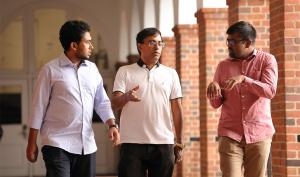Improving Devices at Nano-Computing Level
At the Virginia Nano-Computing Research Group (VINO lab group), our focus is on understanding non-equilibrium properties of nano-scale material structures.We also explore and utilize high performance computational resources including the use numerical algorithms to advance our understanding of nanoscale science and engineering. To address the challenges of extending today’s electronic devices to the next generation of devices, science can no longer work out of context to engineering, but rather both should work in tandem. The interdisciplinary nature of our approach is necessary to explain the science and push the engineering of future devices.
Selected Publications
- Strain effect on band structure of InAlAs digital alloyABSJ. ZHENG, Y. TAN, Y. YUAN, A. W. GHOSH AND J. C. CAMPBELL, JOURNAL OF APPLIED PHYSICS , 125 (8) :082514 (2019).
- Maximization of thermal conductance at interfaces via exponentially mass-graded interlayersABSROUZBEH RASTGARKAFSHGARKOLAEI, JINGJIE ZHANG, CARLOS A. POLANCO, NAM Q. LE, AVIK W. GHOSH, PAMELA M. NORRIS, NANOSCALE (ACCEPTED) (2019).
- Graphene Transistor Based on Tunable Dirac-Fermion-OpticsABSKE WANG, MIRZA M. ELAHI, LEI WANG, K. M. MASUM HABIB, TAKASHI TANIGUCHI, KENJI WATANABE, JAMES HONE, AVIK W. GHOSH, GIL-HO LEE, PHILIP KIM, PROC. NAT. ACAD. SCI. USA (IN PRESS) (2019).
- Machine learning electron correlation in a disordered mediumABSJIANHUA MA, PUHAN ZHANG, YAOHUA TAN, AVIK W. GHOSH, AND GIA-WEI CHERN, PHYSICAL REVIEW B , 99 (8) :085118 (2019).
More About Us
What do we work on?
Research in our group has the advantage of being both curiosity driven and needs driven. Industry is always looking for ways to design or utilize novel materials and devices for new applications. To that end, our research focuses on three aspects of nanoelectronic modeling and simulation:
1. Fundamental physics of current flow in nanosystems:
Traditional CAD tools for electronic conduction are based on macroscopic concepts such as mobility and diffusion that do not apply at nanometer length scales. We look at fundamental physics of current flow including impacts of quantum interference, topological symmetry, inelastic scattering, ‘friction’ and heating due to vibrations and spins, strong non-equilibrium many-body effects, and time-dependent effects due to hysteretic switching, memory, decoherence and noise. Topics include (a) Topological switching such as in skyrmions, pseudospins in graphene, and spins in topological insulators/semi-metals, (b) Unconventional electron-optics such as Veselago effects, Klein/Anti-Klein tunneling, and (c) impact of entanglement.
2. Computational modeling:
Here we develop the formal evolution equations into quantitative simulation tools. This includes semi-empirical as well as ‘first principles’ methods for capturing chemistry, bandstructure and transport, describing the nano-channels and contact surfaces atomistically. Special attention is aimed at multiscaling, band-inversion and embedding techniques to describe hetero-interfaces and surface states, as in hybrid molecule-silicon devices. Examples include band-engineering in III-V tunnel devices and avalanche photodiodes (quarternary digital alloys), thermal engineering at interfaces, and magnetic material design (e.g. Heusler half-metals).
3. Device engineering and unconventional computing:
Here we combine the formal equations with numerical simulations to identify performance advantages and limitations of nanoscale devices and design unconventional computing paradigms, such as tunneling diodes and transistors, ultrafast switches, conductors, interconnects, transistors and electronic sensors made out of various materials such as organic, nanotubes, nanowires, spintronic or magnetic elements and silicon quantum dots. Part of our current interests involve exploring hybrid devices operating on novel principles, such as Klein tunnel transistors for subthremal switching and RF applications, magnet based stochastic computing, and magnetic excitation (skyrmion) based temporal memory.
All of this work is built on a bedrock of non-equilibrium quantum transport, which is our main focus.
